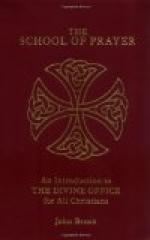(1) The Invocation takes some form such as Deus, Domine.
(2) The motive is commonly introduced by the relative qui; e.g., Deus, qui corda fidelium sancti spiritus illustratione docuisti.
(3) The petition, the body or centre or substance of the prayer, is always noted for the solemn simplicity of language, which marks liturgical prayer, e.g., Multiplica super nos misericordiam tuam.
(4) The purpose is an enforcement of the petition. It has reference, generally, to the need of the petitions and is marked usually with the word ut. “Multiplica super nos misericordiam tuam, ut quae, nobis agendis praecipis, te miserante adimplere possimus” (prayer for feast of St. Patrick).
(5) The conclusion varies, e.g., “Per Dominum nostrum,” “Per eundem Dominum,” etc.
“Those who pay intelligent attention to the liturgical chant at High Mass, and in particular to the chant of the celebrant, will be able to discover for themselves that the intonations used in the singing of the collect and the Post-Communion serve, as a rule, to mark off two at least of the main divisions indicated. Two inflections, a greater and a lesser, occur in the body of the prayer, the greater for the most part coming at the close of the ‘motive,’ while the lessor concludes the ‘petition’ and produces the purpose of the prayer. When the prayers are correctly printed, as in the authentic ‘Missale Romanum,’ the place of the inflexions is indicated by a colon, ‘punctum principals,’ and a semicolon, ‘semi-punctum,’ respectively. These steps, it will he observed, indicate, not precisely ‘breaks in the sense’ (as Haberl incorrectly says) but rather the logical divisions of the sentence, which is not quite the same thing” (Father Lucas, S.J., Holy Mass, chap, vi.).
The question is often asked, why Dominus vobiscum is said after the collect, or prayer. Writers on liturgy reply that it is so placed because Christ frequently used the salutation Pax vobis, and the priest in public prayer holds the place of Christ, and as he, the priest, used this formula of salvation before the collect to obtain the spirit of prayer and the grace of God, he repeats it so that these gifts may be retained.
In the collects, the fatherland of the saints is rarely found, because the saints’ true home and fatherland is heaven, where they were born again to life eternal, and their fatherland is not this valley of exile where they spent their temporal life. Nor are their surnames given in the collects (see the collect of St. Jane Frances Fremiot de Chantel given on p. 180). But it is not infrequent in the collects to find certain appellations characterising a saint or noting some special prerogative or wonderful gift of grace. The Church’s collects record the wonderful gifts of St. John Chrysostom ("the golden-mouthed"), St. Peter Chrysologus ("qui ob auream ejus eloquentiam Chrysologi cognomen adeptus est”) (Rom. Brev.). Sometimes the nation or earthly home of a saint is given in a collect to distinguish one saint from another. This is seen in the case of saints bearing the name of Mary, which if used absolutely or unqualifiedly refers to the Mother of God. See the collects for St. Mary Magdalen, St. Mary of Egypt, etc.




